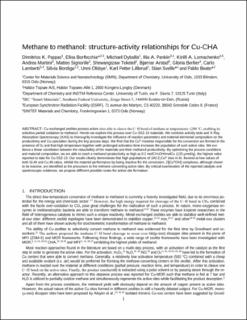| dc.contributor.author | Pappas, Dimitrios | |
| dc.contributor.author | Borfecchia, Elisa | |
| dc.contributor.author | Dyballa, Michael Martin | |
| dc.contributor.author | Pankin, Ilia A. | |
| dc.contributor.author | Lomachenko, Kirill A. | |
| dc.contributor.author | Martini, Andrea | |
| dc.contributor.author | Signorile, Matteo | |
| dc.contributor.author | Teketel, Shewangizaw | |
| dc.contributor.author | Arstad, Bjørnar | |
| dc.contributor.author | Berlier, Gloria | |
| dc.contributor.author | Lamberti, Carlo | |
| dc.contributor.author | Bordiga, Silvia | |
| dc.contributor.author | Olsbye, Unni | |
| dc.contributor.author | Lillerud, Karl Petter | |
| dc.contributor.author | Svelle, Stian | |
| dc.contributor.author | Beato, Pablo | |
| dc.date.accessioned | 2020-12-22T12:48:37Z | |
| dc.date.available | 2020-12-22T12:48:37Z | |
| dc.date.created | 2017-11-13T20:54:50Z | |
| dc.date.issued | 2017 | |
| dc.identifier.citation | Journal of the American Chemical Society. 2017, 139 (42), 14961-14975. | en_US |
| dc.identifier.issn | 0002-7863 | |
| dc.identifier.uri | https://hdl.handle.net/11250/2720792 | |
| dc.description.abstract | Cu-exchanged zeolites possess active sites that are able to cleave the C–H bond of methane at temperatures ≤200 °C, enabling its selective partial oxidation to methanol. Herein we explore this process over Cu-SSZ-13 materials. We combine activity tests and X-ray absorption spectroscopy (XAS) to thoroughly investigate the influence of reaction parameters and material elemental composition on the productivity and Cu speciation during the key process steps. We find that the CuII moieties responsible for the conversion are formed in the presence of O2 and that high temperature together with prolonged activation time increases the population of such active sites. We evidence a linear correlation between the reducibility of the materials and their methanol productivity. By optimizing the process conditions and material composition, we are able to reach a methanol productivity as high as 0.2 mol CH3OH/mol Cu (125 μmol/g), the highest value reported to date for Cu-SSZ-13. Our results clearly demonstrate that high populations of 2Al Z2CuII sites in 6r, favored at low values of both Si:Al and Cu:Al ratios, inhibit the material performance by being inactive for the conversion. Z[CuIIOH] complexes, although shown to be inactive, are identified as the precursors to the methane-converting active sites. By critical examination of the reported catalytic and spectroscopic evidence, we propose different possible routes for active-site formation. | en_US |
| dc.language.iso | eng | en_US |
| dc.publisher | American Chemical Society | en_US |
| dc.subject | Materials | en_US |
| dc.subject | Extraction | en_US |
| dc.subject | Alcohols | en_US |
| dc.subject | Hydrocarbons | en_US |
| dc.subject | X-ray absorption near edge spectroscopy | en_US |
| dc.title | Methane to methanol: structure-activity relationships for Cu-CHA | en_US |
| dc.type | Peer reviewed | en_US |
| dc.type | Journal article | en_US |
| dc.description.version | acceptedVersion | en_US |
| dc.rights.holder | This document is the Accepted Manuscript version of a Published Work that appeared in final form in
Journal of the American Chemical Society, copyright © American Chemical Society after peer review and technical editing by the publisher. To access the final edited and published work see https://pubs.acs.org/doi/10.1021/jacs.7b06472 | en_US |
| dc.source.pagenumber | 14961-14975 | en_US |
| dc.source.volume | 139 | en_US |
| dc.source.journal | Journal of the American Chemical Society | en_US |
| dc.source.issue | 42 | en_US |
| dc.identifier.doi | 10.1021/jacs.7b06472 | |
| dc.identifier.cristin | 1513677 | |
| dc.relation.project | Norges forskningsråd: 247730 | en_US |
| dc.relation.project | Norges forskningsråd: 237922 | en_US |
| cristin.unitcode | 7401,80,3,3 | |
| cristin.unitname | Sorbentbaserte teknologier | |
| cristin.ispublished | true | |
| cristin.fulltext | postprint | |
| cristin.qualitycode | 2 | |
